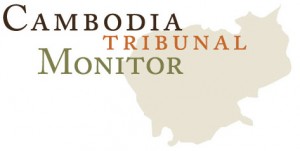Relative of Khmer Rouge Military Official Ta Mok Testifies
Today, August 2, 2016, expert Henri Locard concluded his testimony under questioning of Khieu Samphan Defense Counsel Anta Guissé. He answered questions regarding his methodology and a few questions regarding education sessions and . Next, witness 2-TCW-976, whose name was not revealed due to anonymity reasons, stood his stance. He was related to Ta Mok, who was a former Khmer Rouge official (also known as “Brother Number Five”), but could not give much detail on the questions by the Co-Prosecution. No other parties put questions to him. Last, witness Chin Saroeun was introduced to the Chamber. He will be questioned by the defense teams tomorrow morning.
Training Sessions
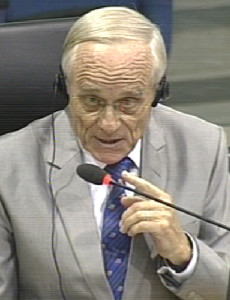
Expert Henri Locard
In the beginning of the session, Judge Ya Sokhan announced the Trial Chamber Nil Nonn was absent due to urgent personal matters and would be replaced by Judge Sokhan for the time being. Judge Sokhan would be replaced by Judge Tou Mony until Judge Nonn returned. National Civil Party Lead Co-Lawyer Pich Ang was absent due to personal reasons.
The floor was granted to Anta Guissé, who inquired about a training session given by Khieu Samphan and wanted to know whether he was sure that Ong Thong Hoeung attended this training session. Expert Henri Locard said he had not slept very well and that he might not be able to answer questions very well: “yesterday you practiced cold torture on me and now I know what cold torture means. I wasn’t able to sleep between one and four in the morning”. He then said that he found it in book that he did attend seminars led by Khieu Samphan. One of the references he gave were Philip Short’s book (p. 316), re-education sessions given by Khieu Samphan were mentioned. Ms. Guissé reminded the witness that she was “only doing [her] job as a counsel”, and that accusing her of torturing him was “a bit excessive”. “In no case am I torturing you”, and she added that “the comparison seems to be a little inappropriate in the courtroom.”
She then referred to Ong Thong Hoeung’s Written Record of Interview, in which he explained that he neither saw Khieu Samphan nor Nuon Chea, nor Ieng Sary, but that his wife had told him about it.[1] Mr. Locard said that “he says clearly” that the seminar was led by Khieu Samphan and was related to the abolishment of family life and also to give up one’s persona and give it to Angkar. Ms. Guissé said that he had quoted Suong Sikhoeun [2] He replied that they had “very long discussions”. He reiterated that this sentence was accurate, after “having read almost everything that was written” on this subject and having interacted for a long time with Khmer Rouge leaders. Suong Sikhouen’s statement was based on his experience in the Ministry of Foreign Affairs.
Ms. Guissé asked whether he spoke to him about the principle of secrecy, which the expert confirmed. She asked how he could align the fact that “pretty much was pretty much doing everything” while at the same time observing the principle of secrecy. He answered that this principle could only be applied to the higher Angkar, who knew everything and could perform several tasks.Next, she referred to the Minutes of a Standing Committee Meeting.[3] He answered that he had not based his work on the internal documents of the Party. First, because he did not have access to it. Second, because he worked based on the victim’s account and not based on the voices of the perpetrators.
Soldiers
He pointed to Comrade Doeun, Comrade Yeng and Comrade Pang “This is a good example that we’re facing total confusion here, it was chaos”. It was not clear, in his view, “who is doing what”.
There were
- people who listened and spied
- the vu teat, general army, stationed in pagodas and barracks, in charge of the prisons, internal security
- elite soldiers (ie in Kampong Thom), guarding borders, carry out flash attack missions, invade Vietnam in 1977 and massacre villages
The vu teat were present in each district.
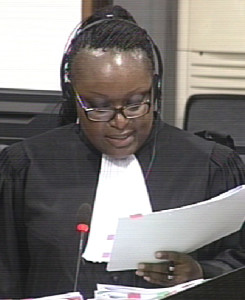
Khieu Samphan Defense Counsel Anta Guissé
She asked about his mentioning of a “bloody dispute” between Son Sen and Sarun.[4] He answered that the assassination of Son Sen and his wife were a last step in a dispute. “We know it was ordered by Pol Pot”. Ms. Guissé repeatedly reminded him to stay focused. He answered that his source was Sarun. He said that Son Sen had been responsible for the assassination of family members of Sarun, who took revenge.
She asked about slogans related to minorities.[5] He answered that he had not heard about slogans against Cham, for example, nor about the Chinese. “The Chinese who have been forgotten in this trial entirely”. Discrimination was directed against religion, he said, but not ethnicity.
She then asked a few follow-up questions about the nature of notes that had been mentioned yesterday about his interview with So Hong. He said that he had notes and recordings. He estimated that there were more than 40 hours of recordings, and the same applied to Sarun. He did not have an index system. The interview with So Hong was transcribed in Khmer and English. He pointed to copyright problems, since he did not consider himself the owner of what Phy Puon had said.
Mr. Koppe requested a copy of the recordings of Mr. Locard’s interview with Pen Sovann. As regards receiving the approval from Phy Phuon’s family “a simple phone call would suffice”. As for Saloth Ban, he could call him too “my Khmer would suffice”. This should be possible by the end of the week.
With this, the expert’s testimony came to a conclusion. Judge Sokhan thanked and dismissed him.
New Witness: 2-TCW-976
He then invited witness 2-TCW-976 into the courtroom. As advised by the Co-Investigating Judges, his pseudonym was used during the hearing.[6] Since the witness could not read, he could not confirm his identity based on his Written Record of Interview.[7]
After the break, the floor was given to the Co-Prosecutors. Assistant Prosecutor Andrew Boyle wanted to know when he joined the Khmer Rouge. He replied that it was in 1979. He could not recall when Democratic Kampuchea was. He said that he joined the Khmer Rouge in Phnom Dun, which was not his home village. Mr. Boyle read his statement, in which he had said that he joined it in his home village Tnut Chum in Takeo.[8] He answered that there was a coup in which they had attacked the Vietnamese. Asked by Mr. Boyle where he joined the Khmer Rouge, he said that he was in Kirivong.
Joining the Khmer Rouge
Mr. Boyle asked about his reason why he joined the Khmer Rouge and pointed to his statement that all of his family members were part of the Khmer Rouge.[9] The witness confirmed this, but then said “my parents at the time were quite old, so I joined the movement alone”. He was “simply a combatant” when he joined the Khmer Rouge. He was a combatant at the zone level. He said he was a zone combatant from the beginning. He then confirmed the statement that Mr. Boyle read out that he was first a commune militiaman before being transferred to the Zone Level Militia.[10] He first could not remember when he joined the zone army. When Mr. Boyle read a statement that he joined it in 1973, he recounted that he was transferred to the Southwest Zone in 1973. [11]
Ta Mok and Other Cadres
Ta Roeun was the commander of the division, he said. He had heard of the name Ta Mok and said that he was the chief of the zone. He said he was not related to Ta Mok. Mr. Boyle said read out two quotes, one saying that he was his nephew and the other that his father was Ta Mok’s nephew.[12] Confronted with this information, the witness said that this was correct. He denied ever having been part of the Party.
Mr. Boyle read a statement, in which he had said that Sarun led his division, namely Division 14.[13] In his Written Record of Interview, he had said that he was part of Division 10. [14] He said that it was Regiment 14 in Division 310.
He said that his commander was replaced by one from the Northwest Zone. He did not know Ta Roeun’s full name. Mr. Boyle asked whether he was familiar with the name Sao Sarun, Sarun 05, which he denied.
He denied ever having attended meetings with the Standing Committee. He did know what position Ta Mok held in the Communist Party of Kampuchea, and only knew that he was chief of the zone. “Ta Mok led the people”. He issued orders to people. Mr. Boyle read an excerpt of the witness’s statement, in which he had said that Ta Mok ranked second after Pol Pot.[15] He confirmed this, “because all soldiers in the infantry belonged to him”. He knew about this, since he built a house for him.
Ta Roeun returned to his village and Ta Mok was the only one who was in charge in Battambang. He could not remember the date. He was no longer in Division 310 later on. He lived with his wife and children “under Ta Mok”. After leaving the division, “I became a house builder for Ta Mok”.
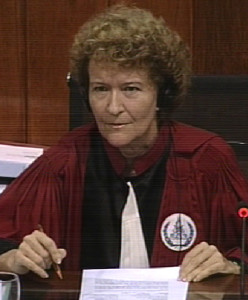
Judge Claudia Fenz
He confirmed having worked as a messenger for Ta Roeun.[16] “There were no major tasks. In fact, I cooked and I served him water and meal”. He also carried messages sometimes in Tram Kak District. He did not remember the year. He delivered messages from one unit to another. He confirmed that he participated in the attack on Phnom Penh. He did not stay in Phnom Penh in April 1975. He went to the Northwest Zone then, he said. This prompted Mr. Boyle to read a statement, in which he had said that he stayed in Phnom Penh for a year.[17] In another statement, he had said that he stayed in Phnom Penh until end of 1975.[18] At this point, Mr. Koppe said that there was an investigation report, which made him wonder whether the witness was “really the person who should be here” in light of the answers.[19] His answers “did not make any sense” in light of earlier answers. Judge Claudia Fenz said the issue would be contemplated during the break.
He was based in Thma Puok in Sector 5 in the Northwest Zone. He was not sure about the Zone. Banteay Chhmar, Krala and Thma Puok were all in the Northwest Zone, he said. He insisted that he had not lived in Phnom Penh. Mr. Boyle read a statement, in which he had said that he lived with Ieng Sary, Pol Pot, and Khieu Samphan, “since they were his leaders”.[20] Mr. Boyle asked whether this statement was not correct. He said it was correct, since he built houses for them.
At this point, the President adjourned the hearing for a break.
Battambang
After the lunch break, Judge Sokhan announced that the session would be held in camera until instructed otherwise. This sessions was held for around twenty minutes, after which the session was open to the public again and the floor handed back to the Co-Prosecution.
Mr. Boyle inquired when he was transferred to Battambang. He first could not remember. When Mr. Boyle confronted him with an excerpt that stated that he was transferred to Battambang during rainy season in 1978, he confirmed this.[21] Ta Mok had made the decision to transfer him. There were other forces there already, who were also under the command of Ta Mok.

Judge Ya Sokhan, Replacing Nil Nonn Today
Mr. Boyle asked whether he was ordered to “get rid of the Northwest people” when he was transferred there. The witness said that he heard other forces saying this. They said that they needed their forces to be there. He did not understand. Judge Sokhan reminded all parties that the witness had not obtained a high level of education. “They only said that the Northwest people had betrayed”. Mr. Boyle asked whether it refreshed his memory that the instructions related to high-level cadres.[22] The witness confirmed this, but said that his force was not there to conduct the purges. He heard rumors and was not personally instructed. This prompted Mr. Boyle to read another excerpt, in which he had said that Ta Mok issued these orders.[23] “I did not see any purges conducted after my arrival”. He insisted that he just heard rumors. Mr. Boyle wanted to know whether it was therefore correct that he received the information that only high-ranking cadres were to be purged stemmed from a rumor, which the witness confirmed.[24] “People were called and disappeared”. He heard that “certain uncles have been called to attend a meeting, and after the meeting, the uncles disappeared”. He did not recall their names. “I was very young […]. I was not allowed to know the business”. He sometimes had to deliver letter, while he was based at his headquarters at other times. He would deliver letters from Ta Mok to the division or regiments. They would not give him letters to deliver back to Ta Mok. He denied acting as a guard. He was a “bricklayer”, he said. Mr. Boyle read an excerpt, in which he had said that Ta Mok used him as a messenger and guards and took him with him sometimes.[25] The witness confirmed this now. Sometimes he was asked at locations “to build hospital”.
Mr. Boyle confronted him with his statement, in which he had said that he followed Ta Mok to rice fields, villages, and worksites.[26] The witness confirmed this. “I was following him at the time.”
Rattanakiri
When the witness denied that he went to Rattanakiri, Mr. Boyle then asked whether it was incorrect that he guarded Chinese Delegations when they visited Rattanakiri.[27] He replied that he was not working with Ta Mok at the time. He then confirmed that he accompanied Ta Mok to Rattanakiri. Ta Mok took the Chinese Delegation to a gold mine in Rattanakiri.
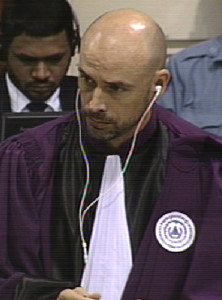
Assistant Prosecutor Andrew Boyle
Mr. Boyle said that he had indicated in his Written Record of Interview that he attended a meeting convened by Ta Mok.[28] The witness answered that Ta Mok held meetings inside his house. “However, I did not know the content of that meeting”. Around three to five people attended the meeting. He had heard of the name Ruos Nhim, but had not seen him in person. He was chief of Sector 05 or of the Zone, the witness thought. Mr. Boyle wanted to know whether he knew someone called Chiel or Ta Tom, which the witness denied. “I only heard of their names”. He did not know where they lived. He was guarding the road, which is when he saw them. “His face looked familiar”. He explained that he saw the two persons. He did not know where they went, but heard that they were going to a meeting.
Turning to his next topic, Mr. Boyle pointed out that he had said that his unit arrested Nhim, while he said later that he was not involved in the arrest, but that he saw a driver who left for Phnom Penh.[29] He now said that he was watering the flowers and saw them in a car. He heard that they were going to a meeting. He did not know who was in charge or who was who, “since I was a minor soldier”. Mr. Boyle wanted to know whether his statement that he knew it because he was working close to Ta Mok was incorrect.[30] He repeated that he saw them leave. Mr. Boyle asked whether it was incorrect that his unit was involved in the arrest.[31] He said that he had said that the cadres were asked to go and work and not actually to go to a meeting.
They were travelling by CMC vehicles to Rattanakiri. Mr. Boyle read out an estimate by the witness that the unit was comprised of more than 1000 people.[32]
Mr. Boyle read an extract, in which he had said that they were surrounded by Ta Nhim’s forces, but that they disappeared when they took up their arms.[33] The witness said that they only engaged in a verbal argument. He recounted that the soldiers “came to see us” getting off the truck. The next morning, they had all disappeared.
Sao Phim
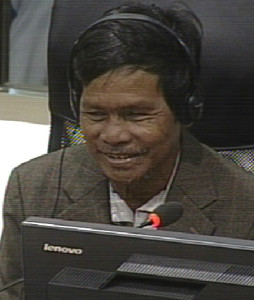
Witness 2-TCW-976
He had only heard of Sao Phim and did not participate in his arrest. Mr. Boyle read his statement, in which he had said that he was directly involved.[34] He now said that he went along with other soldiers, but was not directly involved, since he was young. He went with Regiment 14 forces. A few minutes later, he said that he did not go along with them. He travelled with them, but was not present during the arrest. He could not remember the date. According to Duch’s Written Record of Interview, purges took place in June or July 1978.[35] The witness could still not remember.
Mr. Boyle wanted to know whether he had not already moved to Battambang with the rest of the division at the time. The witness denied this. He did not see him killing people.[36] With this, Mr. Boyle concluded his questioning.
Judge Jean-Marc asked whether it was correct that Ta Sarun, Ta 05, was his unit leader. The witness denied this and said that Ta 05 was another unit leader. Since no other parties had question, Judge Sokhan thanked the witness and dismissed him.
Introduction of a new witness: Chin Saroeun
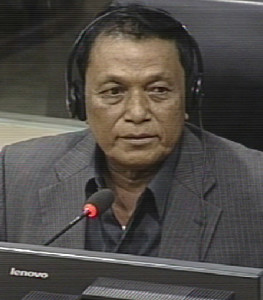
Witness Chin Saroeun
After the last break, Judge Sokhan ordered to usher witness 2-TCW-1028 into the courtroom. Witness Chin Saroeun was born on 4 January 1959. He is in the military region of Mondulkiri at present. He was interviewed once at the military region in Mondulkiri in 2000. After introducing the witness to the Chamber, Judge Sokhan adjourned the hearing to give the defense time to prepare their questioning. The hearing will resume tomorrow, August 3, 2016, at 9 am.
[1] E1/103.1, at 00833728 (FR)
[2] E3/10640, at 01303587 (FR).
[3] E3/182, at 00292868-69, 00183393 (EN), 00019108 (KH).
[4] E3/10640, at 0130XX 590 (FR).
[5] E3/2821, at 00394645 (EN), 00394991 (FR).
[6] E319/48.5.
[7] At 00967994 (KH), 00975005 (EN), 00976333 (FR).
[8] E3/9474, at A1.
[9] E3/9029, at 01060635 (EN), 00930403 (KH).
[10] Ibid., at 01060637 (EN) 00930405 (KH).
[11] 37 (EN) 00930405 (KH)
[12] E3/9029, at 01060635 (EN), 00930404 (KH).
[13] 01060640-41 (EN), 00930407 (KH).
[14] E3/9485, answer 26.
[15] E3/9474, at answer 18.
[16] E3/9029, at 01060657 (EN), 00930422 (KH).
[17] E3/9029, at 01060641 (EN), 00930408 (KH).
[18] E3/9474, at answer 2.
[19] E319/53.2.9
[20] E3/9029, at at 01060642 (EN), 00930409 (KH)
[21] E3/8495, at answer 18.
[22] E3/9474, at answer 52.
[23] E3/9474, at answer 23.
[24] E3/9474, at answer 52 and 53.
[25] E3/9474, at answer 7.
[26] E3/9474, at answer 39.
[27] At answer 39.
[28] E3/9485, at answer 14.
[29] At 01060645 (EN), 00930412 (KH).
[30] E3/9474, at answer 17 and 18.
[31] At 01060646 (EN), 00930413 (KH)
[32] At 01060647 (EN), 00930413-14 (KH)
[33] E3/9474.
[34] At 01060647 (EN), 00930413 (KH).
[35] E3/442, Written Record of Interview of Kaing Guek Eav.
[36] E3/9474, at answer 68.
Featured Image: Witness 2-TCW-976 (ECCC: Flickr).
